Allertor 125
| Allertor 125 | |
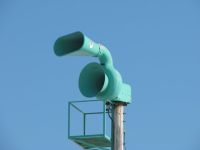 A third gen ACA Allertor 125, located in Whitefish Bay, WI. This unit is due to be replaced by an ASC T-128. | |
| Company | Alerting Communicators of America |
|---|---|
| Produced | 1968-1983 |
| Type | Rotational Electromechanical |
| Sound output | 125-127 dB @ 100 ft |
| Frequency | 60 Hz |
| Horsepower | 10-15 hp |
| Voltage | 208-240/480 V AC 1 or 3 ph |
| Preceded by | BNCO Mobil Directo |
| Succeeded by | ACA Penetrator |
| Documentation | Manual |
The Allertor 125 is a rotational, electromechanical civil defense siren that was produced by Alerting Communicators of America from 1968 until it was replaced by the similar Penetrator series in 1980. Replacing the BNCO Mobil Directo upon its introduction, it competed with Federal Signal's Thunderbolt and 500 series of sirens as a high-power outdoor warning siren.
History and design
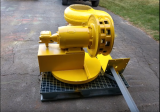
Introduced in 1968 alongside ACA's other 1st generation sirens, the Allertor 125 was the direct successor to Biersach and Niedermeyer (BNCO)'s Mobil Directo siren, with significant improvements to the design which simplified manufacturing and enhanced the siren's durability and performance versus its predecessor. Like the Mobil Directo, it is unique in that it sucks in air through the bottom intake horn, and then the sound comes out of the top horn of the projector.
The Allertor 125 is driven by a dual sided 10 hp or 15 hp AC motor, which drives both the rotor and the rotator. These motors were produced by Baldor and Doerr, and are not cross-compatible as the motors use different adapters.
The siren was rotated as one large unit, with the siren's motor being connected to a gear reducer that then drove a vertical shaft that operated a gear-driven or chain-driven rotator below. This design was quite reliable and a significant improvement over the belt-driven Mobil Directo, as chains do not suffer from the same issues as belts do (such as dry rot) and last much longer. A popular misconception is that the Allertor's chains were prone to snapping, but this is far from the truth as most surviving Allertors have working rotators and failures are uncommon.
Rather than using all-metal construction like its predecessor, ACA used then-brand-new fiberglass construction on these sirens, which greatly improved the siren's longevity and durability as it prevented corrosion and better protected the siren's internals. 1st and 2nd generation models used steel panels for the motor cover before switching to using fiberglass on all external areas for the 3rd generation.
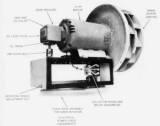
While the projector was efficient, it also proved to be the Allertor's Achilles heel that led to its eventual replacement. Due to the rounded design of the projector, water could easily build up inside the compression drum if the bottom drainage holes were clogged with debris, which could freeze during the winter and result in the rotor getting stuck and burning up the motor during operation. The Howler would be developed in 1972 in an attempt to come up with a better projector design, which was successful. The Penetrator-10 would reuse the Howler's projector design placed on the Allertor 125's core in 1980 which solved the icing problem at the cost of performance. The 9/12-port variants of the Penetrator-10 and 15 are little more than 3rd generation Allertors with a different projector. While the siren was given the name Allertor 125, the siren's rated performance varied between 125-127 dB at 100 ft depending on which manual is referenced.
A three-signal Allertor was offered alongside the standard dual-signal model for a short time, this third signal being the famous "Yelp" signal.
To quote Jim Biersach, "[The Yelp signal was accomplished by a] Louis Allis motor that had 9 leads. It used three contactors that switched the motor from 2 pole 3500 RPM to 600 RPM 12 pole. That made the yelp sound. During the yelp the motor became a generator and put power back on the line. When Louis Allis went out of business we bought special made motors from Doerr Electric in Cedarburg, Wi. I designed a copper core motor that could take the heat made during three phase reversal. We used a two contactor magnetic starter with a timer that reversed the motor for 2 seconds to make the yelp then waited 5 seconds before switching to forward again." - Jim Biersach 12/2022
This was a short-lived option, with only two three-signal units currently known to exist today. None are currently configured to run the Yelp signal. More may be discovered in the future as yelp-capable Allertors have no apparent outward differences.
Single tone 8-port or 12-port were also options, though no single tone units are known to have been sold. A few units in Hoffman Estates, IL were mistaken to be 8-port models, but were proven upon removal to be 8-port Penetrator-15s with 3rd generation Allertor projectors.
In 1980, the Allertor was redesigned into the Penetrator-10 and 15, which replaced the large two-piece projector with a simple horn and intake, which reduced manufacturing costs and solved the icing issues and the difficulty of installation. The new projector did come at the cost of performance, as the Allertor's design offered superior performance over the P-10. The Allertor was sold alongside the P-10 for a short time before being finally discontinued, as can be seen in ACA's 1980 catalogue. Despite its discontinuation, the siren was still supported by ACA and later ASC, with manuals and parts still being available for these sirens for a period of time, likely until the discontinuation of the RM-127 in 2002.
Generations
The Allertor 125 had three different distinct generations:
1st generation
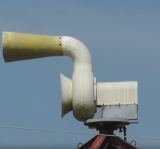
The 1st generation Allertor 125 is easily distinguished from later models by its elongated two-piece motor cover that is taller than later models, and came standard in 10/12-port dual tone (with the chopper and stator being reused from the BN44E Mobil Directo), 8/12-port dual tone, and 9/12-port dual tone. The rotors on 9/12 and 10/12-port 1st generation Allertors are bidirectional, with the 9/12's rotor being very similar in design to the Federal Signal SD-10's rotor. These early Allertors did not use chain-driven rotator, instead using a rotating gear driven by the motor that rotates the siren around a very large stationary gear under the siren. These rotators are much larger in diameter than the chain driven rotators later Allertors used and makes it very easy to spot.
1st generation Allertors also use a smaller intake borrowed from the Mobil Directo, and use the same projector as the Mobil Directo, albeit made of fiberglass and with a shorter L-bend. Jim Biersach has stated the first generation Allertor projecters were in fact molded directly off of the Mobil Directo projector assembly.
These were produced from 1968 until sometime in the very early 1970s. The very earliest of these had a vent on the side of the motor cover, which was later removed. Some units, such as the 8/12-port units, do not have elongated motor covers, similar to Type-2 units. While the 9/12 and 10/12-port rotors and stators on these units are bidirectional, meaning they can run in either direction with identical performance, the 8/12-port rotor and stator are unique in that they are the 1st of ACA's rotational sirens to use a directional rotor and stator, which greatly improves performance when wired correctly, however the siren will perform worse if running backwards. Also unique to the 1st generation Allertors is that the rotor spins in the opposite direction of the rotator, spinning counterclockwise while the siren rotates clockwise. 2nd and 3rd generation Allertors rotate the same direction as the rotor spins, rotating clockwise if configured correctly.
2nd generation
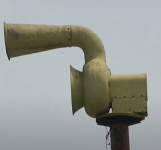
The 2nd generation Allertor was introduced in the very early 1970s, dropping both the 8/12 and 10/12-port options in favour of a redesigned directional 9/12-port rotor and stator, which improved the efficiency of the siren when spinning in the right direction. However, if it is wired backwards, sound output will be reduced. The 2nd generation also switched from the gear-driven rotator to a smaller chain-driven rotator. Early 2nd generation Allertors had a larger, teardrop shaped rounded rotator with a small lip at the end, with later units switching to the smaller design that would be later used in the 3rd generation Allertors. Another way of differentiating these Allertors from the 1st generation models is that the 2nd generation Allertors have a reinforcement lip on the top horn, while 1st generation units do not. Production ended on this generation in 1972, being succeeded by the 3rd generation. 2nd gen units had a very short production run, and are hard to find as a result.
3rd generation
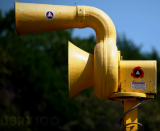
The 3rd generation Allertor was released in 1972, and was the final redesign given to the siren. This is when the siren received the design it is most well known for, and switched to an all-fibreglass construction instead of the previous mix of fibreglass and steel. Like the previous generation, the 3rd generation Allertor came exclusively in 9/12-port dual tone, using the same directional rotor and stator as the 2nd generation units. The intake was greatly enlarged in order to prevent snow and ice from getting into the projector, and the motor cover was redesigned from a two-piece fibreglass and steel design to a single, shorter fibreglass mould. This design decision forced ACA to add an indent into the back of the projector drum to allow it to fit onto the rotator plate. This means that projectors from previous generations are incompatible. The Allertor would be replaced by the Penetrator series in 1980, although it was available as late as 1983. Due to its design, the Allertor outperforms the dual tone P-10 and P-15 by 1 decibel.